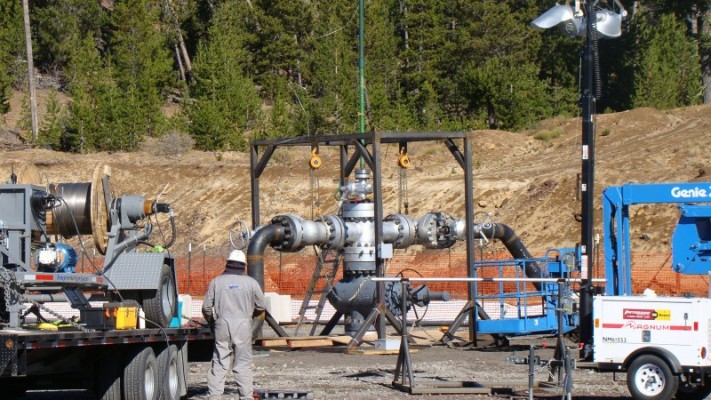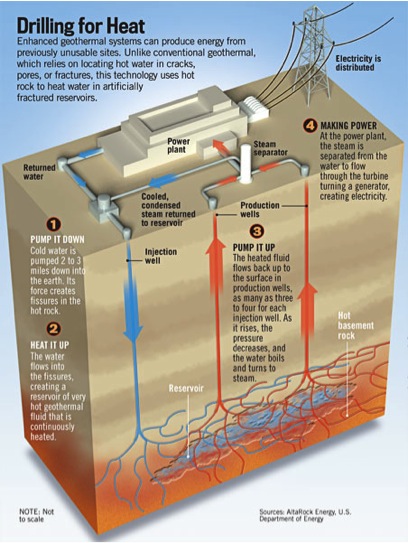Digging deep
Finding power potential beneath a volcano
Alexa C. Kurzius • January 17, 2013
When looking for new sources of clean energy, why not tap into Earth’s own natural furnaces? Volcanoes, with their bottomless heat and energy supply, may be a promising power source thanks to recent advances in harnessing geothermal power.
AltaRock Energy, based in Seattle, is using its new technology to explore using super-heated rock beneath Oregon’s Newberry Volcano to generate electricity.
“The places where geothermal energy is the most promising are where there are active volcanoes. Newberry is one of those places,” said Andrew Meigs, a geology professor at Oregon State University who oversaw an AltaRock-funded undergraduate research project analyzing topographic data in the Newberry region. Volcanoes are potentially ideal spots for geothermal energy projects because they’re more likely to contain magma, or molten rock. And where there is magma that means there is enormous heat keeping the rock in a liquid state.
When another company, Davenport Newberry Holdings, drilled a well into the volcano looking for fluid in 2008, they didn’t find any. AltaRock, on the other hand, is testing a method that doesn’t rely on finding fluid. Instead, the company wants to create underground reservoirs where water can be pumped in from the surface, warmed by the nearby hot rock, and then pumped back up and turned to steam to drive a turbine and generate power.
Since October, the company has been pumping water and the plastic into the old Davenport well, to test its ability to create the reservoirs, a process AltaRock calls hydroshearing. The company uses an injection well to pump cool, pressurized water into existing cracks in the rocks, expanding them by one to two millimeters and creating an underground network of interconnected fissures that can hold water as it’s being heated by surrounding rock. Hydroshearing differs from hydraulic fracturing, or fracking, the controversial practice that forces a high-pressure chemical mixture to break apart underground rock and release oil and natural gas. AltaRock’s work is being funded by a $22.5 million grant from the U.S. Department of Energy.

AltaRock’s injection well, pumping water below the ground to create geothermal reservoirs [Image credit: Dave Stowe]
AltaRock plans to create three reservoirs, but that can happen only if the injected water flows where the company wants it to go. To control the flow direction by temporarily blocking some of the cracks, AltaRock founder Susan Petty has developed a corn-based plastic that can withstand 400 to 600+ degrees of underground heat and pressure without melting. In a week or so, after the need for water diversion has ended, the plastic plugs disappear, decomposing harmlessly into carbon dioxide and water.
The injection well is only half of the circulation system, however. The company will also need to drill an extraction well to collect the water after it has been superheated and then use its steam to generate electricity. The idea is to create a closed loop system in which the circulating water is continuously heated and cooled. “You are bringing up hot water, turning a turbine, and re-injecting cooled water into subsurface to be heated again,” explained Zach Frone, a doctoral student at Southern Methodist University who previously worked on geothermal projects at Davenport.

How enhanced geothermal systems can potentially fuel a power plant. [Image credit: AltaRock Energy, U.S. Department of Energy]
Because it uses injection to create a man-made reservoir, AltaRock’s technique is considered an enhanced geothermal system. Conventional geothermal systems, which tap naturally occurring underground sources of steam and hot water, have been used for a half-century in places like El Salvador, Iceland, and the Philippines that are blessed with ample sources of hot, underground water. But enhanced systems have not yet been successfully implemented, mostly because it’s so difficult to create additional reservoirs. Working in deep wells is required to create an enhanced system, said Lauren Boyd, a spokesperson for the U.S. Department of Energy’s geothermal technologies program. “In many cases, drilling and logging tools struggle to operate” for long periods of time under conditions of high temperature and pressure, she said.
Geothermal energy currently produces less than half of one percent of America’s electricity, according to a report put out by the Geothermal Energy Association. But the U.S. Department of Energy estimates that 100,000 megawatts of electricity—the equivalent of powering about 10,000,000 homes—may be available within 50 years if enhanced geothermal systems become more widespread. It is a prized source of power not only because it doesn’t generate pollution or contribute to global warming, but also because unlike wind and solar power, geothermal functions around the clock no matter the weather or season, according to Dave Stowe, a spokesman for the Newberry geothermal project.
A successful venture by AltaRock would show that enhanced geothermal systems could be created in hard volcanic rock where no fluid existed previously. This would open the door to energy production in hard bedrock or deep sedimentary basins, not just volcanoes. The U.S. isn’t the only country that understands this potential; Australia is hoping to create an enhanced system with a technique of of its own, drilling into hard granite rock in the Cooper Basin.
AltaRock is currently working at Newberry to see if it can create the three reservoirs, drill the additional wells needed, and test the flow of the system. If all goes well, it will design and build a small demonstration power plant as early as 2016, with the hopes of expanding it down the line if it performs well and they receive the permits to do so.* Theoretically, a larger plant on the site could produce 30 to 50 megawatts of electricity for about 50,000 houses, according to Stowe. “Geothermal energy is the cleanest source of power we have,” he said, and enhanced geothermal systems have “the potential to provide a very significant portion of our energy supply.”
*Correction, January 21, 2013:
Originally, this article read that the 2016 power plant would be built to produce 50 megawatts of power. This is inaccurate. The power plant is planned to initially function as a smaller demonstration plant, with the possibility of further expansion.